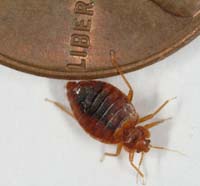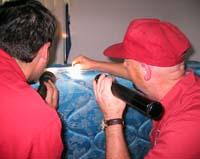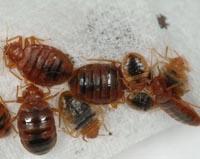Bedbug Resurgence Creating Interest, Anxiety
Bedbug Resurgence Creating Interest, Anxiety


photo: Michael Potter
When Michael Potter’s phone rings – and it rings a lot these days – there’s a good chance someone wants to talk about bedbugs. And with good reason.
After some 50 years of near extinction in the United States, bedbugs are back, wreaking havoc in bedrooms and other sleeping areas across the country. Potter, an entomologist at the University of Kentucky College of Agriculture, is the much sought-after expert on the topic.
“I’m basically trying to bang the drum and get the word out about bedbugs so that the public can begin to understand this critter,” said Potter, who in recent weeks has fielded calls from “Dateline NBC,” The New York Times, The Wall Street Journal, The Washington Post, and “Inside Edition.”
It’s not that Potter has great affection for the bedbug, a tiny, oval-shaped pest with vampire-like habits. “This is a cryptic, blood-sucking parasite that emerges at night to bite you while you’re sleeping,” he said.

photo: Michael Potter
What Potter does have is vast knowledge of the creature made famous in a children’s nursery rhyme and whose resurgence in the past few years has created as much anxiety as it has interest. It’s that expertise that makes him eager to expound on the subject.
“People need to be aware this is not a childhood nursery rhyme,” said Potter, who is working closely with UK entomologists Ken Haynes and Dan Potter and doctoral student Alvaro Romero to study the “hottest bug issue in a generation.”
The bedbug, or Cimex lectularius, has been around since ancient times but didn’t find its way to America until the 1500s. Bedbug infestations in this country became especially common in the early part of the 20th century.
The bugs practically vanished after World War II, however, and Americans enjoyed a long period of bedbug-free nights. They first “hit the radar screen” again in 2001.
“I’ve been out on – and this is not an exaggeration – hundreds of bedbug infestations in the past two to three years. Prior to that, I had not ever encountered one,” Potter said.
Theories abound as to why there’s been a resurgence of bedbug infestations. Potter believes it’s most likely a result of changing cultural habits, including increased international travel to and emigration from countries where the bugs are prevalent, including Asia, Africa, Europe, the Caribbean and Central/South America. The practice of recycling mattresses and buying secondhand furnishings may also have contributed to the resurgence.
“Bedbugs are amazing hitchhikers,” he said. “They cling to anything. It doesn’t take much for a bedbug to get into a suitcase during a hotel stay.”
Along with many pest control experts, Potter believes bedbugs are making a comeback because the pesticides that once controlled the bugs have been banned.
“DDT was a phenomenal bedbug product that was used in the ‘40s, ‘50s and ‘60s before we lost it (in 1972). We have lost a number of products in the last five years. We do not have products today that are nearly as effective,” Potter said.
In addition, once bedbugs are introduced into a dwelling, they tend to spread room to room or apartment to apartment, creating a widespread and difficult-to-control infestation.
“People ask me, ‘What can I do to try to prevent these infestations?’ This is where it gets difficult,” he said. “There’s a whole lot of things that are more likely to happen than you getting bedbugs…but it can happen. The best thing to do is to know the likely ways they can get into your home.”
Potter also advises people to know the symptoms of a bedbug problem.
“I tell people if you were fine when you went to sleep and you wake up in the morning and you’ve got mosquito-like welts on you, that’s suspicious,” he said.
If a person does suspect a bedbug problem, he should call a pest control professional. A professional is trained to spot the pests, whose flat shape and small size make it easy for them to hide in such places as seams, tufts and crevices of a mattress and in box springs, bed frames and headboards. While the bed is “ground zero,” Potter stresses that bedbugs are also found in couches, behind picture frames and other protected locations.
As for treatments, there are a variety of low-odor sprays, dusts and aerosols that professionals can use against bedbugs. Treatments should be targeted yet thorough and often require follow-ups, Potter said.
A dwindling cache of weapons that effectively control bedbugs, coupled with the fact that few people in the pest control industry had ever seen a bedbug until a few years ago, creates what Potter calls the “perfect storm.”
“There’s not going to be an easy fix,” he said. “We’ve got this blood-sucking parasite in your house biting you at night, and the products today aren’t nearly as effective. We also have a pest control industry that’s still learning to deal with this critter. I hate to sound negative, but it really looks like this pest is going to be a real challenge.”
If there is good news about bedbugs, it’s that they are not known to spread diseases, Potter said.
“But just because they don’t spread diseases doesn’t mean they’re not a problem,” he added. “They’re creepy. They cause great anxiety. There’s a social stigma associated with them. It’s just very disconcerting when you have bedbugs living with you.”
